





Lure these gorgeous black and orange beauties into your yard with the right plants.
(Editor's Note: This article was originally published on August 19, 2008. Your comments are welcome, but please be aware that authors of previously published articles may not be able to respond to your questions.)
Since 1975, the Monarch (Danaus plexippus) has been the state insect of Illinois. The choice was suggested by a third-grader who, no doubt enjoyed watching one of the most recognizable butterflies in the state. Being from Illinois myself, I can understand the attraction the Monarch holds for those that watch this orange and black gem gently float over cornfields and country roadsides.
In more recent times however, the Monarch butterfly population has declined. Like other butterflies, habitat destruction and pesticide use are often the culprits. While gardeners often supply nectar plants for all butterflies, some are unaware of the needs of the Monarch larva. Many others simply do not know or understand the impact of a simple act like mowing a patch of milkweed has on the Monarch.
As the saying goes — Knowledge is Power. Let's go back to science class for a Monarch Butterfly Lesson.
The Monarch is one of the most identifiable butterflies in the United States. It's orange and black wings stand out brightly in the summer blue sky, while its size makes it viewable from a distance. The Viceroy possesses similar colors and veining — an extra horizontal strip on its lower wings readily distinguishes this butterfly from a Monarch. The Monarch below center shows two oval spots on the lower wings. These are scent glands that can be seen from the front or back of the wing and indicate that this butterfly is a male. Additionally, females have thicker black veining to distinguish them.
Female Monarch
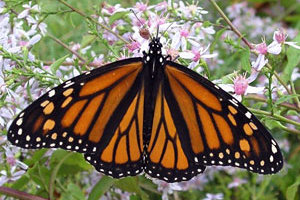
Male Monarch
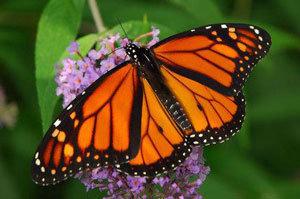
Viceroy
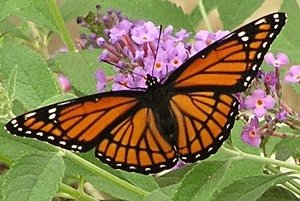
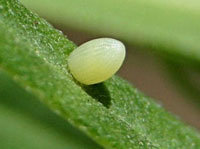
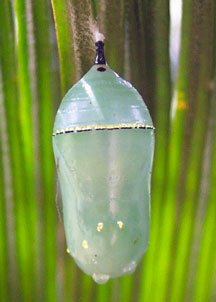
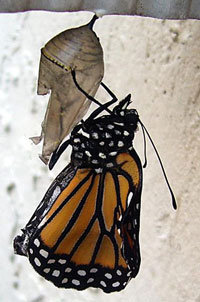
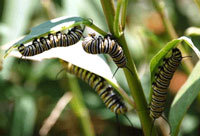
Like most butterflies, Monarchs experience four stages in their month long life cycles — egg, larva, pupa and adult. Females lay eggs on host plants (milkweed, see below). The oval eggs are about the size of the head of a pin — large enough to be seen by the unaided eye. Approximately four days after eggs are laid, the larva will begin to eat its way out of the hard shell by eating the shell itself.
In the larval or caterpillar stage, the Monarch undergoes five phases, or "instars" lasting nine to 14 days. The body of the caterpillar features a head, abdomen and thorax. They have six pairs of eyes but their vision is poor. To aid them in sensing their way around the milkweed, they have front and rear tentacles. They breathe by taking in oxygen through holes in the sides of their bodies.
During their phases the Monarchs are eating machines, growing so large between phases that they must shed their skin. The molting starts at the head and peels back to the rest of the body. The caterpillar then eats this shed skin before continuing to eat more milkweed.
When a Monarch is ready to pupate, the caterpillar crawls to a spot where it can hang and form a chrysalis. First it makes a silk pad (on a branch or such) to which it attaches its rear end by a spike called the "cremaster." They it forms a "J" shape and begins to split its skin for the last time (to see a wonderful pictorial display of this, check out the pictures from 'kennedyh' in the Bug Files). This last skin is the "chrysalis" — it begins soft but later hardens. During this stage, the Monarch must continue to hang to form properly. When it is close to emerging, the wings will develop their orange and black pigment and the pupa will darken.
The adult Monarch emerges in 10 to 14 days. The wings are still wet at this time and need about three to four hours to dry. After this waiting period, the adult butterfly is ready to fly, provided temperatures are warm enough (60º). Summer adults are ready to mate in three to eight days and the process begins all over again. The summer adult Monarch lives from two to five weeks. The last generation of the summer however live much longer, about nine months, in order to migrate and reproduce in the spring.
In late summer and early fall a portion of the North America Monarch butterfly population migrates south. Some from the east coat overwinter in southern Florida, but most find their way to the mountains of central Mexico. The University of Kansas Biological Research department operates Monarch Watch, a Monarch butterfly education and research program. According to Monarch Watch, migration dates begin in Canada as early as August 18th. By October 10th, Monarchs in Houston, Texas will begin their journey south.
The Monarch Lab at the University of Minnesota offers wonderful research on the fall migration. They cite day length, temperatures and host plant quality as factors in creating the physiological differences in late season Monarchs. These Monarchs are those that will make the journey south where can overwinter. Journey North, an educational site monitoring seasonal change, tracks both fall and spring migrations of Monarch butterflies. Tracking for Journey North’s 2008 fall season begins August 28th.
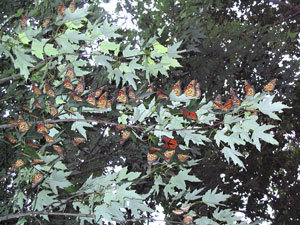 The winter roosts in Mexico (and in California for western populations) enable scientists and researchers to monitor and provide colony counts each year. With this data, researchers can see population growths and decline from each year. When the overwintering Monarch's make their trip back north into Texas in March, they will produce the first generation of the year and die. This first generation will continue the migration north through June.
The winter roosts in Mexico (and in California for western populations) enable scientists and researchers to monitor and provide colony counts each year. With this data, researchers can see population growths and decline from each year. When the overwintering Monarch's make their trip back north into Texas in March, they will produce the first generation of the year and die. This first generation will continue the migration north through June.
Monarch butterflies can be found in many habitats: country roadsides, suburban gardens even city parks. If they find a source of both nectar and host plants, the Monarch will be happy. Host plants are those on which the female butterfly lays her eggs and on which the caterpillars will feed. For Monarch butterflies, the host plants are those within the Milkweed (asclepias) family.
My Mother tells a story about walking country roads as a child and collecting the silky portions of seeds from milkweed pods. The silk was used for life preservers for World War II servicemen. Growing up, this common milkweed (Asclepias syriaca) was the only milkweed that I ever knew about. According to the U.S. Government however, there are over 100 species of milkweed — a portion are known important hosts for Monarchs. .
Monarch Watch offers the "Monarch Waystation Program" to help increase and protect Monarch habitats. They encourage citizens to develop Monarch Waystations in any areas possible (gardens, parks, schools, roadsides, unused plots, etc.) This program hopes to restore milkweed habitats and provide feeding stations for migrating butterflies. Waystations sites may be certified and/or registered and provide wonderful educational opportunities. The program sells seed kits of the following host and nectar plants. If you are looking to entice Monarchs to your garden, these plants are ideal choices.
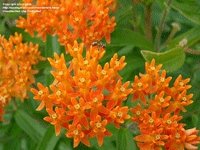
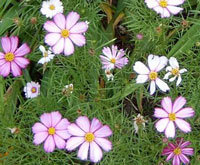
COSMOS, Dwarf Sensation Mix (Cosmos bipinnatus)
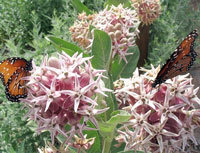 SHOWY MILKWEED
SHOWY MILKWEED  JOE PYE WEED (Eupatorium purpureum)
JOE PYE WEED (Eupatorium purpureum)
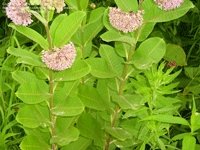 COMMON MILKWEED
COMMON MILKWEED  FLOSS FLOWER, Blue Horizon (Ageratum houstonianum)
FLOSS FLOWER, Blue Horizon (Ageratum houstonianum)

SWAMP MILKWEED
(Asclepias incarnata)
(Asclepias incarnata subsp. pulchra not shown)
 PURPLE CONEFLOWER
PURPLE CONEFLOWER 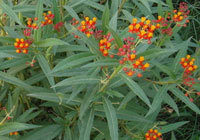 TROPICAL MILKWEED (Asclepias currassavica)
TROPICAL MILKWEED (Asclepias currassavica)
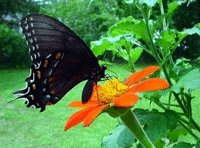 TITHONIA TORCH Mexican Sunflower (Tithonia rotundifolia)
TITHONIA TORCH Mexican Sunflower (Tithonia rotundifolia)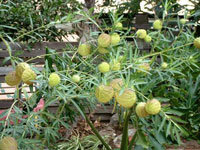 SWAN PLANT (Asclepias fruiticosa)
SWAN PLANT (Asclepias fruiticosa)
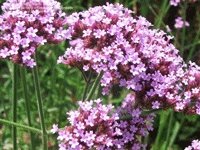
UPRIGHT VERBENA (Verbena bonariensis)
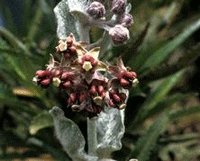 PURPLE MILKWEED (Asclepias cordifolia)
NOTE: The Cynanchum genus of the milkweed family (Swallow wort) is toxic to Monarch caterpillars.
PURPLE MILKWEED (Asclepias cordifolia)
NOTE: The Cynanchum genus of the milkweed family (Swallow wort) is toxic to Monarch caterpillars.
There are few monarch predators, which threaten the Monarch. You might think that birds would be their largest threat. Birds however take notice of the orange and black colors to remind them not to eat the Monarch which has a chemical defense on its side. By ingesting milkweed as caterpillars, Monarchs develop a poison in their bodies. When a bird takes a bite of a Monarch, it tastes the poison and spits the butterfly out. Predators of greater concern are parasitic wasps, bacteria or viruses. The Viceroy butterfly pictured above, takes advantage of similar coloring to ward off predators.
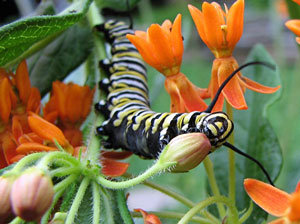 Certainly the biggest threat to the Monarch population is the destruction of their natural environment. Habitats in North America have been dwindling on a large scale due to increased housing and industrial growth. Additionally, a good portion of the country's milkweed grows in rural areas where it is subject to mowing and pesticides. With limited host plants, Monarch reproduction is at risk. Even in urban and suburban areas there are pesticide threats. If you are concerned about butterfly populations in general, consider eliminating pesticides from your garden.
Certainly the biggest threat to the Monarch population is the destruction of their natural environment. Habitats in North America have been dwindling on a large scale due to increased housing and industrial growth. Additionally, a good portion of the country's milkweed grows in rural areas where it is subject to mowing and pesticides. With limited host plants, Monarch reproduction is at risk. Even in urban and suburban areas there are pesticide threats. If you are concerned about butterfly populations in general, consider eliminating pesticides from your garden.
Additionally, Monarchs are finding their Mexican roosting environments at risk of destruction. There are 12 locations in central Mexico where the colonies are found. While these areas are protected by the Mexican government, illegal logging has become a problem in the area. Mexican and International organizations are working to further conservation in these areas.
Citizen Science is described by the U.S. government as " the collection of scientific data by individuals who are not professional scientists." Volunteers from various programs gather data to better understand the Monarch butterfly. Journey North and the Texas Monarch Watch collect migration data, while Monarch Watch offers waystation seed kits and tagging kits. The University of Minnesota runs the Monarch Larva Monitoring Project to collect data on Monarch larva and milkweed habitats.
These organizations offer ways in which you can help with research and improve habitat. If you have access to public or private lands such as at a school, church, or government facility, consider developing a Monarch Waystation. If you'd like to increase Monarch butterflies in your yard, add some milkweed host plants to your garden. Many members of Dave's Garden enjoy raising caterpillars. Upon discovery of eggs or caterpillars, the foster parents provide the offspring a safe environment and food for growth. It is a fun and educational experience for the young and old alike. To learn more about raising your own Monarchs, visit the Hummingbird and Butterfly Forum.
By mid-August, the Monarchs in my garden are visiting regularly even if they are not cooperating with picture taking. The common milkweed is currently host to a caterpillar with a huge appetite and my phlox is a favorite with all butterfly species. I want to offer the Monarchs and others as many opportunities to reproduce and thrive in my garden as I can. With some basic knowledge, you can too.
Aren't all these images gorgeous? These pictures are all found in the PlantFiles and BugFiles here at Dave's Garden. Click on each one to open the full-sized original. Many thanks to the following contributors.
BugFiles:
kniphofia, hczone6, okus
kennedyh, onalee, jnana, snuzer29, Erynne, Magpye
PlantFiles:
richteaz, Xenomorf, creekwalker, rebecca 101, cactus_lover, Ulrich, sladeofsky, crowelli, hczone6, jkom51, dale_a_gardener, airren, Marilynbeth
How Does Your Garden Glow - Decorating Your Garden.
Setting Up Your Vegetable Garden
Planting Perennials in Your Garden
Attracting Butterflies, Hummingbirds and Other Pollinators
Help Monarchs and Other Butterflies by Planting Common Milkweed
Invite Mining Bees to Your Garden by Planting Their Favorite Plants
Copyright © www.100flowers.win Botanic Garden All Rights Reserved